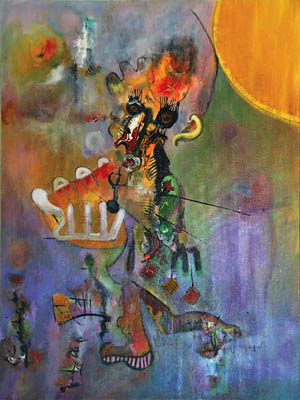Paintings & Poems/Poems & Paintings.
At Artamo Gallery. Shows through December 30.

Words can have a deadening effect on images, and images can do the same to words. An image can be stopped in its tracks by an interpretation that shuts down the ongoing play it offers, and an image can become a mere illustration to a text, cutting off the imagination’s trajectory.
So the project underway at Artamo, Paintings & Poems/Poems & Paintings, which involves the pairing of images and words, is a tricky one. Fortunately, it has been approached in so many different ways, and draws on such strong material, that it can’t help but succeed.
Consider the series by Janet Bothne: As the artist found images of woods emerging from her painterly experiments, she titled the paintings (“Stopping by Woods to Dance,” “Stopping by Woods to Paint,” “Stopping by Woods to Dream”) in honor of “Stopping by Woods on a Snowy Evening” by Robert Frost. If the canvases had been studies in white and grey-or even in any vaguely wintery or monochromatic colors-the effect would have been deadly. But the canvasses are some of the most coloristically variegated and saturated around. They refuse the status of easy accompaniment for a well-known poem, opening up questions about the woods we see depicted, about the poem, about the nature of sight, and of representation.
Similarly, “On Our Way to Wherever,” a poem by Perie Longo, asks as many questions about “Threshold No. 20” by artist Suha Sin as it answers, becoming deeply imbued with the painting’s atmosphere, but leaving the image its own space to reverberate. David Starkey, a poet who has responded to four of the paintings, does so in a different way each time, producing something like uninterrupted, though quirky, ekphrasis for “Sorcerer” by Norton Wright, inventing a subject matter for “Inca Sunrise” by the same artist, and making Gordon Huether’s “Sheet Metal Series III, No. 3” speak, if not sing.
If owner Jack Mohr is in the gallery when you are there, be sure to get him to tell you about the relationship between his paintings and the poems by his wife, E.M. Laskowski-Caujolle. The stories-some of the paintings were inspired by lines from the poems, some of the poems respond to paintings, some pairings emerged in parallel synchronicity, and so on-make it clear that the inspiration flowing between the two has a life of its own. Indeed, one of the pleasures of this show is tracing the community connections that have been formed, between artist and poet and between reader and viewer, largely around the nucleolus of this active and dedicated gallery.



